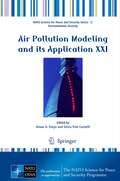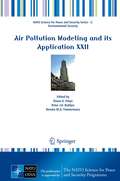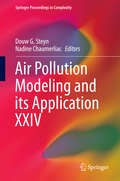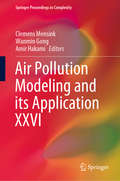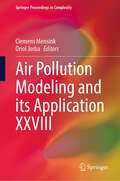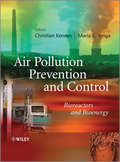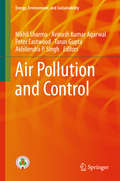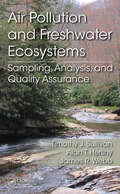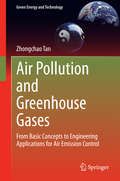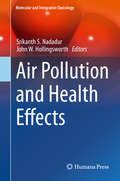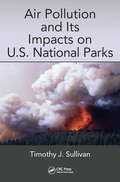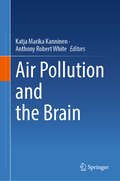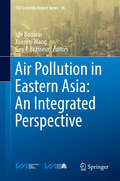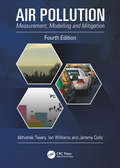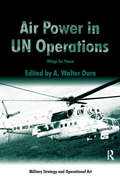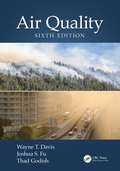- Table View
- List View
Air Pollution Modeling and its Application XX (NATO Science for Peace and Security Series C: Environmental Security)
by Douw G. Steyn S. T. RaoRecent developments in air pollution modelling are explored as a series of contributions from researchers at the forefront of their field. This book on air pollution modelling and its application is focused on local, urban, regional and intercontinental modelling; data assimilation and air quality forecasting; model assessment and evaluation; aerosol transformation; the relationship between air quality and human health and the effects of climate change on air quality. It consists of a series of papers that were presented at the 30th NATO/SPS International Technical Meeting on Air Pollution Modelling and its Application held in San Francisco, U.S.A., May 18-22, 2009. It is intended as reference material for students and professors interested in air pollution modelling at the graduate level as well as researchers and professionals involved in developing and utilizing air pollution models.
Air Pollution Modeling and its Application XXI (NATO Science for Peace and Security Series C: Environmental Security)
by Douw G. Steyn Silvia Trini CastelliRecent developments in air pollution modeling and its application are explored here in contributions by researchers at the forefront of their field. The book is focused on local, urban, regional and intercontinental modeling; data assimilation and air quality forecasting; model assessment and evaluation; aerosol transformation; the relationship between air quality and human health and the effects of climate change on air quality. The work will provide useful reference material for students and professors interested in air pollution modeling at the graduate level as well as researchers and professionals involved in developing and utilizing air pollution models.
Air Pollution Modeling and its Application XXII (NATO Science for Peace and Security Series C: Environmental Security)
by Douw G. Steyn Peter J.H. Builtjes Renske M.A. TimmermansRecent developments in air pollution modeling and its application are explored here in contributions by researchers at the forefront of their field. The book is focused on local, urban, regional and intercontinental modeling; data assimilation and air quality forecasting; model assessment and evaluation; aerosol transformation; the relationship between air quality and human health and the interaction between climate change and air quality. The work will provide useful reference material for students and professors interested in air pollution modeling at the graduate level as well as researchers and professionals involved in developing and utilizing air pollution models.
Air Pollution Modeling and its Application XXIII (Springer Proceedings in Complexity)
by Douw Steyn Rohit MathurRecent developments in air pollution modelling are explored as a series of contributions from researchers at the forefront of their field. This newest contribution on air pollution modelling and its application is focused on local, urban, regional and intercontinental modelling; data assimilation and air quality forecasting; model assessment and evaluation; aerosol transformation. Additionally, this work also examines the relationship between air quality and human health and the effects of climate change on air quality. The work derives from a series of papers presented at the 33rd International Technical Meeting on Air Pollution Modelling and its Application held in Miami, USA, August 27 - 31, 2013. The book is intended as reference material for students and professors interested in air pollution modelling at the graduate level as well as researchers and professionals involved in developing and utilizing air pollution models.
Air Pollution Modeling and its Application XXIV (Springer Proceedings in Complexity)
by Douw G. Steyn Nadine ChaumerliacCurrent developments in air pollution modelling are explored as a series of contributions from researchers at the forefront of their field. This newest contribution on air pollution modelling and its application is focused on local, urban, regional and intercontinental modelling; data assimilation and air quality forecasting; model assessment and evaluation; aerosol transformation. Additionally, this work also examines the relationship between air quality and human health and the effects of climate change on air quality. The work is comprised of selected papers presented at the 34th International Technical Meeting on Air Pollution Modelling and its Application held in Montpellier, France in 2015. The book is intended as reference material for students and professors interested in air pollution modelling at the graduate level as well as researchers and professionals involved in developing and utilizing air pollution models.
Air Pollution Modeling and its Application XXVI (Springer Proceedings in Complexity)
by Clemens Mensink Wanmin Gong Amir HakamiCurrent developments in air pollution modeling are explored as a series of contributions from researchers at the forefront of their field. This newest contribution on air pollution modeling and its application is focused on local, urban, regional and intercontinental modeling; emission modeling and processing; data assimilation and air quality forecasting; model assessment and evaluation; atmospheric aerosols. Additionally, this work also examines the relationship between air quality and human health and the effects of climate change on air quality.This work is a collection of selected papers presented at the 36th International Technical Meeting on Air Pollution Modeling and its Application, held in Ottawa, Canada, May 14-18, 2018.The book is intended as reference material for students and professors interested in air pollution modeling at the graduate level as well as researchers and professionals involved in developing and utilizing air pollution models.
Air Pollution Modeling and its Application XXVII (Springer Proceedings in Complexity)
by Clemens Mensink Volker MatthiasThis book is intended as reference material for students and professors interested in air pollution modeling at the graduate level as well as researchers and professionals involved in developing and utilizing air pollution models. Current developments in air pollution modeling are explored as a series of contributions from researchers at the forefront of their field. This newest contribution on air pollution modeling and its application is focused on local, urban, regional and intercontinental modeling; emission modeling and processing; data assimilation and air quality forecasting; model assessment and evaluation; aerosol transformation. Additionally, this work also examines the relationship between air quality and human health and the effects of climate change on air quality.This work is a collection of selected papers presented at the 37th International Technical Meeting on Air Pollution Modeling and its Application, held in Hamburg, Germany, September 23-27, 2019.
Air Pollution Modeling and its Application XXVIII (Springer Proceedings in Complexity)
by Clemens Mensink Oriol JorbaThis book states that current developments in air pollution modeling are explored as a series of contributions from researchers at the forefront of their field. This newest contribution on air pollution modeling and its application is focused on local, urban, regional and intercontinental modeling; long-term modeling and trend analysis; data assimilation and air quality forecasting; model assessment and evaluation; aerosol transformation. Additionally, this work also examines the relationship between air quality and human health and the effects of climate change on air quality.This work is a collection of selected papers presented at the 38th International Technical Meeting on Air Pollution Modeling and its Application, held in Barcelona, Spain, Oct 18–22, 2021. The book is intended as reference material for students and professors interested in air pollution modeling at the graduate level as well as researchers and professionals involved in developing and utilizing air pollution models.
Air Pollution Prevention and Control
by Maria C. Veiga Christian KennesIn recent years, air pollution has become a major worldwide concern. Air pollutants can affect metabolic activity, impede healthy development, and exhibit carcinogenic and toxic properties in humans. Over the past two decades, the use of microbes to remove pollutants from contaminated air streams has become a widely accepted and efficient alternative to the classical physical and chemical treatment technologies. Air Pollution Prevention and Control: Bioreactors and Bioenergy focusses on these biotechnological alternatives looking at both the optimization of bioreactors and the development of cleaner biofuels.Structured in five parts, the book covers:Fundamentals and microbiological aspectsBiofilters, bioscrubbers and other end-of-pipe treatment technologiesSpecific applications of bioreactorsBiofuels production from pollutants and renewable resources (including biogas, biohydrogen, biodiesel and bioethanol) and its environmental impactsCase studies of applications including biotrickling filtration of waste gases, industrial bioscrubbers applied in different industries and biogas upgradingAir Pollution Prevention and Control: Bioreactors and Bioenergy is the first reference work to give a broad overview of bioprocesses for the mitigation of air pollution. Primarily intended for researchers and students in environmental engineering, biotechnology and applied microbiology, the book will also be of interest to industrial and governmental researchers.
Air Pollution and Control (Energy, Environment, and Sustainability)
by Avinash Kumar Agarwal Tarun Gupta Akhilendra P Singh Nikhil Sharma Peter EastwoodThis book focuses on various aspects related to air pollution, including major sources of air pollution, measurement techniques, modeling studies and solution approaches to control. The book also presents case studies on measuring air pollution in major urban areas, such as Delhi, India. The book examines vehicles as a source of air pollution and addresses the quantitative analysis of engine exhaust emissions. Subsequent chapters discuss particulate matter from engines and coal-fired power plants as a major pollutant, as well as emission control techniques using various after treatment systems. The book's final chapter considers future perspectives and a way forward for sustainable development. It also discusses several emission control techniques that will gain relevance in the future, when stricter emission norms will be enforced for international combustion (IC) engines as well as power plants. Given its breadth of coverage, the book will benefit a wide variety of readers, including researchers, professionals, and policymakers.
Air Pollution and Environmental Health (Environmental Chemistry for a Sustainable World #20)
by Pallavi Saxena Anju SrivastavaAir pollution is an alarming problem, not only in terms of air quality, but also in relation to health issues. Toxic air pollutant concentrations produce harmful impacts on plant health and human health. Further, though there are various sources of air pollution, anthropogenic and biogenic sources are becoming increasingly problematic. A number of control methods have been applied to reduce the air pollutant concentrations so that their global environmental burden on plants as well as humans can be mitigated. However, as confirmed in numerous reports and studies, their concentrations continue to be very high and everyday cases related to air pollution have become exponentially high not only in developing countries but also in developed countries. In plants, toxic air quality has various adverse effects, including biochemical and physiological disorders, chronic diseases and/or lower yields. In humans, air pollutants affect the body’s metabolism and immune system, lungs and central nervous system. This book provides an essential overview of air pollution, its impacts on plant and human health, and potential control strategies. The respective chapters cover general monitoring and characterization techniques for air pollutants, air quality modelling applications, plant and human health effects, risk assessment, and air pollution control policy. Given its scope, the book offers a valuable and unique resource for students of Environmental Science, Biological Science, Medical Science and Agriculture; and for environmental consultants, researchers and other professionals whose work involves air quality, plant and human related research.
Air Pollution and Freshwater Ecosystems: Sampling, Analysis, and Quality Assurance
by Timothy J Sullivan Alan T. Herlihy James R. WebbA practical book for professionals who rely on water quality data for decision making, this book is based on three decades experience of three highly published water and watershed resource professionals. It focuses on the analysis of air pollution sensitive waters and the consequent effects associated with soil and water acidification, nutrient-
Air Pollution and Greenhouse Gases: From Basic Concepts to Engineering Applications for Air Emission Control (Green Energy and Technology)
by Zhongchao TanThis textbook discusses engineering principles relating to air pollution and greenhouse gases (GHGs); it focuses on engineering principles and designs of related devices and equipment for air emission control for a variety of industries such as energy, chemical, and transportation industries. The book aims primarily at senior undergraduate and graduate students in mechanical, chemical and/or environmental engineering departments; it can also be used as a reference book by technical staff and design engineers who are interested in and need to have technical knowledge in air pollution and GHGs. The book is motivated by recent rapid advances in air pollution and greenhouse gas emissions and their control technologies. In addition to classic topics related to air pollution, this book is also featured with emerging topics related to air pollution and GHGs. It covers recent advances in engineering approaches to the reduction of GHG emissions including, but are not limited to, green energy technologies and carbon sequestration and storage. It also introduces an emerging topic in air pollution, which is referred to as Nano Air Pollution. It is a growing concern in air pollution, but largely missing in similar books, likely because of recent rapid advances in nanotechnology has outpaced the advances in nano air pollution control.
Air Pollution and Health Effects (Molecular and Integrative Toxicology)
by Srikanth S. Nadadur John W. HollingsworthExposure to ambient air pollutants, both indoors and outdoors has been associated with the exacerbation and also in the etiology of diverse human diseases. This book offers an overview of our current understanding of air pollution health risks and how this knowledge is being used in the regulatory, therapeutic intervention measures to protect the public health and reduce the disease burden caused by acute and long-term exposure to air pollutants. Air Pollution and Health Effects provides readers with a comprehensive understanding of air pollution health risks, morbidity and the global disease burden, whilst also delivering critical review on state of the art research so as to gain a fundamental understanding of the biological mechanisms involved in the etiology of air pollution-induced diseases. Chapters range from pregnancy outcomes and pre-term birth, carcinogens in the ambient aerosol and the health consequences of indoor biomass burning. Special emphasis is placed on regional and local air pollution and its impact on global health along with suitable preventive and interventional measures. With contributions from international experts in the field this volume is a valuable guide for researchers and clinicians in toxicology, medicine and public health as well as industry and government regulatory scientists involved in health protection.
Air Pollution and Its Complications: From the Regional to the Global Scale (Springer Atmospheric Sciences)
by Pallavi Saxena Shani TiwariThis book provides an overview of the fundamental concept of air pollution, emission sources of air pollutants and their transportation.First, the book presents a brief background on air pollution and its emission sources, then it continues with their impact on agriculture, health, and climate change. Furthermore, it covers the basic concepts of air pollution, transportation of air pollutants, global climate change and the use of science in air pollution policy formulation in detail. It also emphasizes the effects of air pollutants in altering the onset pattern of the Indian Summer Monsoon. In addition, it describes the impacts of air pollution on the cryosphere and human health.In this book the editors provide an interdisciplinary unique collection of new studies and findings on the groove of air pollution, to improve the basic understanding of graduate students as well as researchers in the field of air pollution and its impacts on various aspects of the atmosphere and surroundings. This collection covers the basic concepts of air pollution, transportation of air pollutants, and global climate change and the use of science in air pollution policy formulation.
Air Pollution and Its Impacts on U.S. National Parks
by Timothy J. SullivanA variety of air pollutants are emitted into the atmosphere from human-caused and natural emissions sources throughout the United States and elsewhere. These contaminants impact sensitive natural resources in wilderness, including the national parks. The system of national parks in the United States is among our greatest assets. This book provides a compilation and synthesis of current scientific understanding regarding the causes and effects of these pollutants within national park lands. It describes pollutant emissions, deposition, and exposures; it identifies the critical (tipping point) loads of pollutant deposition at which adverse impacts are manifested.
Air Pollution and the Brain
by Katja Marika Kanninen Anthony Robert WhiteThis book showcases recent findings on the effects of air pollution on the brain throughout the lifespan, describing different types of pollutants, the mechanisms involved in brain impacts, and a description of the brain diseases associated with exposure. The major authorities in the field present the first book on this topic of growing interest with new information just now becoming available. Among the topics explored are cellular mechanisms induced by air pollution, effects of air pollution on the developing brain, and air pollution and cognition. Air Pollution and the Brain has implications not only for health but also for regulatory agencies working to set limit values for health-harming air pollutants.
Air Pollution and the Electromagnetic Phenomena as Incitants (Electromagnetic Frequency Sensitivities)
by William J. ReaThe field of electromagnetic sensitivity is the new epidemic of the 21st century, and can cause disease of the automatic nerve system in any part of the body. This is as a result of chemical sensitivity, in which over 80,000 chemicals are involved, resulting in innumerable combinations. A cursory understanding of the combinations can help clinicians partially understand the associated problems and thus help in the diagnosis and treatment of electromagnetic sensitivities. But a basic understanding of environmentally induced illness and healing must first be understood by the clinicians before diseases occur such as cardiac arrhythmia, muscle spasms, and nerve pain.
Air Pollution in Eastern Asia: An Integrated Perspective (ISSI Scientific Report Series #16)
by Xuemei Wang Idir Bouarar Guy P. BrasseurThis book, written by an international group of experts from China, Europe and the USA, presents a broad and comprehensive analysis of the chemical and meteorological processes responsible for the formation of air pollutants in eastern Asia, and in particular for the development of severe pollution episodes observed primarily during winter in the northeastern part of China. With the rapid population growth, economic development and urbanization occurring in Asia, air pollution has become a major environmental problem in this part of the world. The book is organized around six distinct parts. The first part of the volume offers a general perspective on issues related to air pollution including persistent haze events in eastern and southern Asia. The second part presents an overview of air pollution sources (i. e. , anthropogenic and biomass burning sources). The third part analyzes in-situ observations of chemical species in China, while the fourth part focuses on space observations of gas-phase and aerosol species. The modeling aspects are treated in the fifth part of the volume, which includes a presentation of several air quality forecast systems and an assessment of the role of urbanization on air pollution levels. Finally, the effects of air pollution on health and crop productivity in China are discussed in the last part of the book. The book also presents an integrated view of past and present situations in Asia and provides the scientific basis from which mitigation policies can be established and air quality can be improved. Audience: This book is written for scientists, educators, students, environmental managers, policy-makers and leaders in public administration and private corporations who wish to use science-based information to mitigate air pollution. The book should help decision-makers to design effective policies for air quality improvement and to successfully manage short-term air pollution episodes that substantially affect people's quality of life and strongly impact the economy.
Air Pollution: Health and Environmental Impacts
by Luisa T. Molina Bhola R. Gurjar Chandra S. P. OjhaAir pollution is recognized as one of the leading contributors to the global environmental burden of disease, even in countries with relatively low concentrations of air pollution. Air Pollution: Health and Environmental Impacts examines the effect of this complex problem on human health and the environment in different settings around the world. I
Air Pollution: Measurement, Modelling and Mitigation (4th Edition)
by Ian Williams Abhishek TiwaryThis established textbook offers a one-stop, comprehensive coverage of air pollution, all in an easy-reading and accessible style. The fourth edition, broadly updated and developed throughout, includes a brand-new chapter providing a broader overview to the topic for general reading, and presents fresh materials on air pollution modelling, mitigation and control, tailored to the needs of both amateur and specialist users. Retaining a quantitative perspective, the covered topics include: gaseous and particulate air pollutants, measurement techniques, meteorology and modelling, area sources, mobile sources, indoor air, effects on plants, materials, humans and animals, impact on climate change and ozone profiles and air quality legislations. This edition also includes a final chapter covering a suite of sampling and laboratory practical experiments that can be used for either classroom teachings, or as part of research projects. As with previous editions, the book is aimed to serve as a useful reading resource for upper-level undergraduate and postgraduate courses specialising in air pollution, with dedicated case studies at the end of each chapter, as well as a list of revision questions provided at the end as a complementary section.
Air Pollution: Measurement, Modelling and Mitigation, Third Edition
by Jeremy Colls Abhishek TiwaryA one stop, comprehensive textbook, covering the three essential components of air pollution science. The Third Edition has been updated with the latest developments, especially the inclusion of new information on the role of air pollutants in climate change. The authors give greater coverage to the developing economies around the world where air pollution problems are on the rise. The Third Edition continues to cover a wide range of air quality issues, retaining a quantitative perspective. Topics covered include - gaseous and particulate air pollutants, measurement techniques, meteorology and dispersion modelling, mobile sources, indoor air, effects on plants, materials, humans and animals. Moving away from classical toxic air pollutants, there is a chapter on climate change and another on the depletion of stratospheric ozone. A special feature of this new edition is the inclusion of a fresh chapter on air pollution mitigation by vegetation, mainly its role in maintaining a sustainable urban environment. Recommended for upper-level undergraduate and postgraduate courses specialising in air pollution, both for environmental scientists and engineers. The new material included in the Third Edition extends its use by practitioners in consultancies or local authorities.
Air Power in UN Operations: Wings for Peace (Military Strategy and Operational Art)
by A. Walter DornAir power for warfighting is a story that's been told many times. Air power for peacekeeping and UN enforcement is a story that desperately needs to be told. For the first-time, this volume covers the fascinating range of aerial peace functions. In rich detail it describes: aircraft transporting vital supplies to UN peacekeepers and massive amounts of humanitarian aid to war-affected populations; aircraft serving as the 'eyes in sky' to keep watch for the world organization; and combat aircraft enforcing the peace. Rich poignant case studies illuminate the past and present use of UN air power, pointing the way for the future. This book impressively fills the large gap in the current literature on peace operations, on the United Nations and on air power generally.
Air Purifier: Property, Assessment and Applications
by Zhonglin XuThis book discusses the development, types and application principles of portable air purifiers in China. It analyzes the theoretical characteristics of air purifiers under various operational conditions, and points out that the term “Clean Air Delivery Rate” cannot be used to precisely reflect the problems that occur under various operational conditions. By comparing theoretical and measured data, it highlights the mainfeatures of air purifiers and key points in the design process for different applications. Calculation methods for the indoor particle concentration and the self-purification time are also provided. The book describes the conditions for window opening in smog and for selecting air purifiers, and proposes a newmethod for improvingtheir measurement. In closing, it includes a new assessment index.
Air Quality
by Joshua S. Fu Wayne T. DavisThe sixth edition of a bestseller, Air Quality provides students with a comprehensive overview of air quality, the science that continues to provide a better understanding of atmospheric chemistry and its effects on public health and the environment, and the regulatory and technological management practices employed in achieving air quality goals. Maintaining the practical approach that has made previous editions popular, the chapters have been reorganized, new material has been added, less relevant material has been deleted, and new images have been added, particularly those from Earth satellites. New in the Sixth Edition New graphics, images, and an appended list of unit conversions New problems and questions Presents all-new information on the state of air quality monitoring Provides the latest updates on air quality legislation in the United States Updates the effects of air pollution and CO2 on climate change Examines the effects of the latest changes in energy production and the related emissions and pollutants Offers broadened coverage of air pollutant emissions and air quality in a global context This new edition elucidates the challenges we face in our efforts to protect and enhance the quality of the nation’s air. It also highlights the growing global awareness of air quality issues, climate change, and public health concerns in the developing world. The breadth of coverage, review questions at the end of each chapter, extensive glossary, and list of readings place the tools for understanding into your students’ hands.

